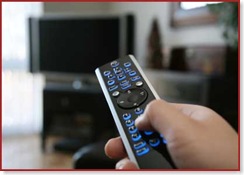>
I met with my local cable reps this week about using video on demand (VOD) for local clients. It’s something you might consider using to differentiate yourself in the market. It’s a relatively new advertising platform and largely goes unused by local businesses. Any business can place video on demand content through local cable outlets, though some smaller operations may not offer the service.
What is Video On Demand?
It’s video content that doesn’t run unless someone orders it. Any subscriber with digital cable can select any VOD program and watch it at any time, on demand. It runs outside of normal cable channel programming on special channels dedicated to VOD content.
Video on demand is available in most homes that subscribe to digital cable. Currently, approximately 65% of cables subscribers have digital cable, which equals about 35% of all U.S. homes. While most cable subscribers have VOD service, only 21% of of people actually use video on demand.
How to Use Video On Demand
Avoid just re-purposing your current commercials. Just like using online video, there are no time limitations with VOD, unless your cable operator arbitrarily imposes them. So get creative. You can do long form video such as product demonstrations, interviews, or infomercials.
You can even produce your own cable show. Some cable companies are doing it already. Tampa Bay cable provider Bright House Networks has hired a former TV anchor to produce a video-on-demand program profiling local entertainment establishments called Murphy’s Hot Spots.
Waco, Texas Realtor Carla Yager is using Video on Demand to broadcast her own listings show. She is pleased with the results. Yager says that buyer interest has picked up on some of the listings shown in the show, with customers quoting descriptions used in the video. She says she has also picked up more listings because sellers see that she is differentiating herself. In addition, website traffic has also increased since the show began broadcasting. Waco Time Warner Cable also broadcasts the video on YouTube. Here is Yager’s show:
Pros and Cons of Video on Demand
The biggest challenge of using VOD is getting people to find your content. Most people don’t go surfing the local on-demand channels looking for local advertising. That means you have to promote your show the old-fashioned way. Yager uses her cable advertising schedule to promote her own on-demand video. In addition to advertising your video, you can send out email notices and ask your customers to spread the word.
Another challenge is getting the video produced. Your local cable operator will produce the video for you, for a fee. Depending on market size, that cost can be any where from $300 to $1000. You can also produce it yourself if you have advanced video skills. This is something you cannot do on a Flip camera. However with a high-quality camcorder and a good external microphone, you may be able to create your own videos. Call your local cable operator and ask for their video specs.
Perhaps the biggest advantage of VOD is interest. The video is on demand so if someone is watching your video, they are watching because they’re interested. So even if the audience is smaller, the audience may actually have greater potential because everyone watching has interest.
In addition, the space is wide open. The VOD medium is largely untapped by local advertisers. And those who use it typically just re-purpose their current advertising. That means you can easily be an important player. Get creative and show your personality. Do videos that no one else is doing. Think of VOD like you would online video. Answer customers questions, show cool stuff that creates interest in you.
It’s ironic that an undiscovered opportunity can be found with traditional media. While everyone else is rushing to promote online, you might be able to find results on local cable TV. How would you use video on demand to promote your business?
For updates on new articles: Receive The Marketing Spot by Email or ![]() Get The Marketing Spot in a blog reader
Get The Marketing Spot in a blog reader

